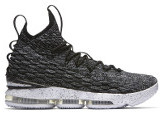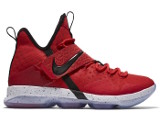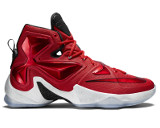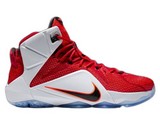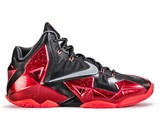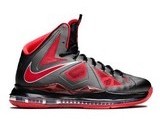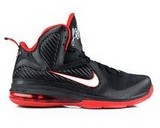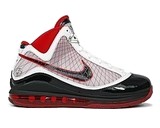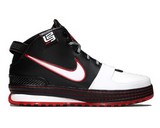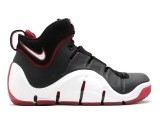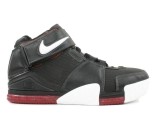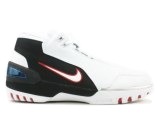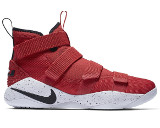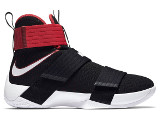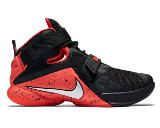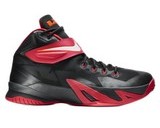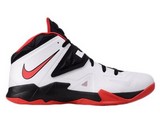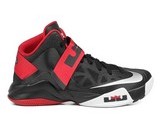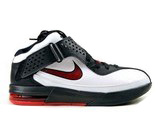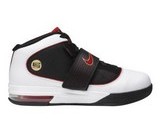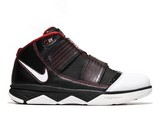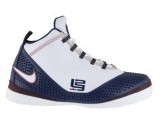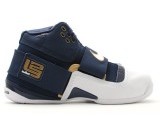Homepage > Reviews > Nike LeBron AZG
Note: The NikeLeBron.net crew puts a lot of effort into running this website. That is the reason why instead of writing our own reviews we find the best ones for our readers. The author of this review is the one and only Professor K and it is the Kicksology.net property published here as a mirror of that famous and inactive website. All the photos and information are the property of their respective owners.
 |
|---|
Introduction
Does the Nike Air Zoom Generation, the first shoe designed for teen phenom LeBron James, mark the beginning of a new era of greatness for the Swoosh? |
To be honest, who cares? I suppose a sizeable contingent at a certain Beaverton address does, but to the everyday baller it’s about hoop, not hype. If that’s your perspective you’re in the right place, because this review is firmly focused on the performance of the Air Zoom Generation. If you want to know about fashion go look at Vogue. If you want to know about financial implications go read the Wall Street Journal. If you want to know about on-court aptitude, keep your eyeballs rolling on down this page.
Before getting started, though, I want to send out my sincere thanks to Asad for the hookup on the extremely hard to find white/white – midnight navy – varsity crimson (aka 1st Game) colorway of the Air Zoom Generation. We wouldn’t have been able to bring you the photos you see here without him, so much love Asad!
Moving on to the review – all the hype around the Air Zoom Generation, including the overblown and over-reported tidbit that its design was inspired in part by James’ infamous Hummer H2, has overshadowed the fact that it is, on its own merits, an interesting shoe. It harks back to the old school to a degree I’ve never seen in an individually endorsed product from Nike. Historically, Nike’s endorsed (aka signature) shoes have been technological tours de force, embodying the state of the art in athletic footwear for their day. The shoes in the Air Jordan line are a great example of this, as are Penny Hardaway’s signature shoes from back in the day (including the wildly innovative Air Foamposite One), and Vince Carter’s current line of Shox-based shoes.
 |
|---|
| Figure 1. This shot provides a good look at the outsole of the Nike Air Zoom Generation. The shoe employs a slight variation on the tried-and-true zig-zag herringbone pattern. The difference is that the ridges on the Generation’s outsole have a flattened surface, whereas the ridges on a traditional herringbone outsole are sharply angled. Traction provided by the outsole was good. Also visible here is a portion of the Air Zoom Generation’s full-length carbon fiber spring plate (it’s the red and black checkered structure visible through the cutouts under the middle portion of the outsole). See the full review for more on this. |
Overview
The Air Zoom Generation, while employing several materials and technologies still considered high-tech, is a shoe that could, by and large, have been released back when the only “crisis” gripping the nation was what exactly President Clinton did with a certain overeager intern (ah, the good ol’ days). The difference is, back then, it would have retailed for $150, while today it retails for $110 – an unheard of figure for a Nike signature shoe (in an interesting bit of historical continuity, the Air Zoom Generation’s retail price is within a few cents of the inflation adjusted price of the Air Jordan I, which hit the market at $65.00 back in 1985). So does that make the Air Zoom Generation a good value in today’s dollars, or an also ran, already past its prime? As I’ll bet Bill said, let’s start from the top and work our way down…
The one entirely new element designed into the Air Zoom Generation is its Sphere inner bootie. For those unfamiliar with Sphere or booties, let me break this down a bit. A shoe with an inner bootie has a sock-like layer built-in to its inner. Generally lined with a smooth, elastic material (often Lycra), the bootie protects the foot from any seams and stitching exposed within the inner, and provides a closer, more comfortable fit. Nike has been building hoops shoes with inner booties since the early 90s, so the bootie, while still a big plus, is not new.
Although new-er, Nike Sphere does not quite qualify as new either. First introduced a couple of years ago in apparel, Sphere is a fabric technology that employs a combination of structural design and material properties to create what Nike calls a “personal atmosphere.” Central to this is a repeating pattern of dimples – in some applications they’re round and in others square – built into the fabric. The dimples prevent a given piece of apparel, be it a shirt, shorts, or a jacket, from clinging to the body, even when soaked with sweat. Instead, the dimples cause a thin layer of air to form between the body and the fabric, regulating temperature (i.e. keeping you a little cooler when it’s hot outside and a little warmer when it’s cold) and increasing airflow. The increased airflow, combined with the intrinsic moisture wicking properties of Sphere material, also speeds the evaporation of perspiration; keeping you cool while you’re active and preventing that nasty clammy feeling when you’re not.
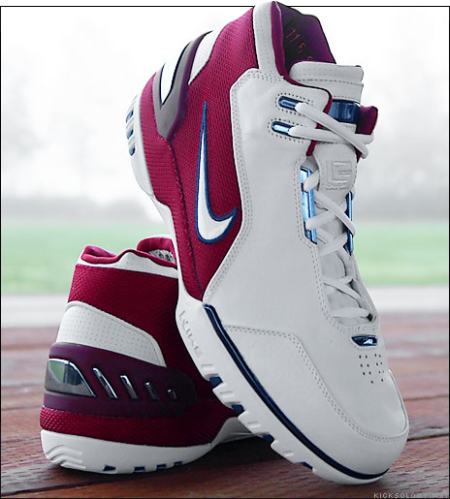 |
|---|
| Figure 2. Here the metal “rails” integrated into the Nike Air Zoom Generation’s lacing system are clearly visible, as are the metal eyelets (modeled after the wheels on the Hummer H2) at the ankle. The blue tint, which matches the blue accent on the Cleveland Cavaliers’ new uniforms, is a nice touch. Up at the ankle you can see part of the numbers “11-5-2003” stitched into the ankle. The numbers mark the date of LeBron’s first home game as well as the release date of this limited edition colorway. |
So booties are old hat and Sphere has been around…”what’s new” you ask? The truly new part is that the Air Zoom Generation marks the first application of Sphere within a shoe. When I read about this a little while back I thought it simply meant that the Zoom Generation’s inner bootie would be lined with the dimpled Sphere material, but when I finally got my hands on a pair I found that the bootie is actually silky smooth. This puzzled me until I felt around within the shoe. What I realized then is that Nike didn’t just slap on some fabric and call it a day. If you think about it for a minute, that wouldn’t have made much sense; the inner of a shoe is pressed right up against the foot so, while the Sphere material would have helped wick moisture away, the central idea of a “personal atmosphere” would have been nullified. It would have been Sphere in name, but not in function.
To Nike’s credit, instead of taking the chintzy route, the company went the extra mile to apply the true Sphere concept to the inner bootie of the Air Zoom Generation. They accomplished this by sandwiching a thin layer of padding between the inner and outer surfaces of the Zoom Generation’s bootie. The entirety of this padded layer – from the tip of the toebox to the collar around the ankle – is marked by a repeating pattern of circular cutouts (the holes are about the diameter of a pencil eraser – see figure 6). The circular cutouts act just like the dimples in Sphere fabric; they lead to the formation of a thin layer of air between the foot and the outer layer of the bootie, regulating temperature, increasing airflow, and dissipating perspiration.
I have no way of quantifying the effects of the Sphere inner bootie, but I can say that the Air Zoom Generation was supremely comfortable for every minute of my eight test wearings. The smooth, nearly seam-free lining of the bootie and the thin layer of padding encased within it certainly helped, but I can also say that my feet never felt hot – even at the end of a grueling two-hour session of full-court action. I can’t say that heat build-up has ever been a big problem for me, but extraordinary comfort is always a big plus.
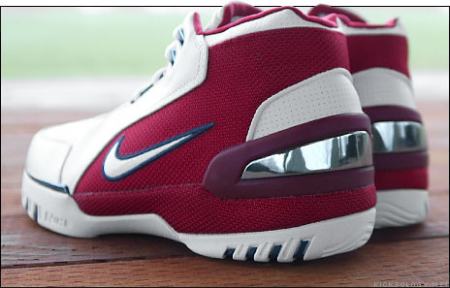 |
|---|
| Figure 3. This shot provides a good look at the large “bumper” built into the heel of the Nike Air Zoom Generation. It helps lock down the heel and is a major contributor to the shoe’s overall stability. Made of thermoplastic urethane (i.e. heat formed plastic), the bumper and prominent chrome accents scuff very easily, but any damage will be purely cosmetic. The structure is beefy and built to last. |
Impressions
The only downside to the Sphere inner bootie is that padding at the ankle is minimal, limiting the amount of support the Air Zoom Generation can provide. The shoe is cut relatively high for a modern-day mid and fit around the ankle was excellent, but because the ankle-area is only lightly padded, the shoe did not provide as much support as I had expected (it’s good, just not as good as the cut would lead you to expect). The good thing is that other aspects of the Zoom Generation’s design allowed me to play without worrying about my ankles, but more on that in a minute. Before going there, let me talk about fit, because that’s another area where I felt the shoe could have been better.
The Air Zoom Generation locks things down by way of a hidden eyestay lacing system augmented with metal “lace rails” over the midfoot and metallic eyelets at the ankle. I’m pretty sure the lace rails are meant to provide a more secure base for the laces, allowing them to do a better job holding down the foot and preventing movement within the shoe. Unfortunately, while the rails look cool, they didn’t really deliver for me in the fit department. Side-to-side fit was excellent, particularly at the forefoot, where I felt absolutely no movement, but during full-court play I could feel my foot shifting forward within the shoe on hard stops. During half-court play I didn’t notice this at all, but the rigors of full-court action seemed to ruffle the Zoom Generation’s fit system a bit, no matter how tightly I laced the shoe. The problem with front-to-back movement is that it can allow the toes to get mashed up against the front of the toebox and that’s exactly what happened to me. I didn’t end up with broken toenails or purple toes, but I did come away with some postgame soreness.
I think there are two culprits here; an overly pliable upper and a pancake flat footbed. First, the upper; I mentioned above that the Air Zoom Generation was supremely comfortable thanks to its built-in Sphere inner bootie, but at least some of the credit also needs to go to the shoe’s soft, supple outer. In the case of the limited edition white/white – midnight navy – varsity crimson colorway pictured here and the widely released white/white – varsity red – black colorway, the outer is made of a combination of full-grain leather and a lightweight fabric with a knit texture. These materials work hand-in-glove with the Sphere inner bootie to help the shoe breathe, and their pliability makes the shoe feel great right out of the box, but neither provides the rigidity necessary to help the lacing system keep the foot completely locked down during really hard stops. All but one of the remaining colorways of the Zoom Generation will feature fully leather uppers, which should help in this regard (though the elimination of the textile will almost certainly have a negative impact on ventilation), but strategic use of synthetic panels, as in the recently reviewed New Balance BB885, could have been even more effective.
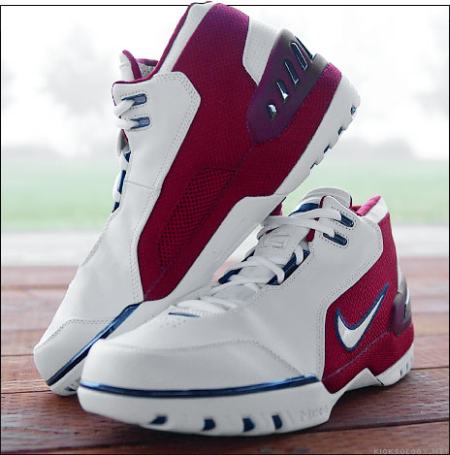 |
|---|
| Figure 4. It’s clear that heat and moisture management were key concerns in the development of the Nike Air Zoom Generation. First there’s the Sphere inner bootie built into the shoe, but the materials and design of the outer also maximize airflow. An obvious example is the large vent cut out of the medial side of the shoe as visible above. |
As for the footbed; in short, it’s flat. There’s a slight ridge under the arch, but that’s about it. People used to wearing old-school shoes will probably like this because the Zoom Generation will feel familiar, but those accustomed to the level of midfoot support provided by most modern-day athletic shoes may find this a bit disconcerting. Aside from providing almost no support underfoot, the flatness of the footbed makes it a good deal easier for the foot to slide back-and-forth within the shoe. An insole insert would be a big help on both fronts – just keep in mind that the Zoom Generation’s sockliner is glued in.
So the flatness was a downer, but everything else about the Air Zoom Generation’s feel underfoot was a joy. The shoe is built on a lightweight Phylon midsole augmented with a low-profile Zoom Air unit within the forefoot and a standard Air-Sole unit within the heel. Because the Zoom Air unit is fully encased within the midsole, the Zoom Generation does not provide as “springy” a feel as a shoe like the Air Ultraposite (which has a full-length Zoom Air unit built into its sockliner), but after a couple wearings the Generation did provide a nice, responsive feel up front. Even the heel provided a nice bit of cush once the midsole was broken in (after my second wearing).
Down at court level, the Zoom Generation features a solid rubber outsole with a minor variation on the tried-and-true herringbone pattern. Traction wasn’t Spidey-like, but it was above average, and the outsole looks like it should hold up well to wear both indoors and out.
 |
|---|
| Figure 5. Seeing the Nike Air Zoom Generation in profile always conjures up visions of the Air Jordan III and IV in my mind’s eye. I’m not sure why – there just seems to be something in the overall shape and the eyestay treatment. I guess that shouldn’t come as all that much of a surprise given that Tinker Hatfield, the designer behind every Air Jordan shoe from the III to the XV, participated in the design of the Air Zoom Generation. Also involved in the design were Aaron Cooper and Eric Avar. That trio has more creative ability in their dead skin cells than the entire eastern seaboard – I’m talking more juice than Tropicana (seriously)! |
Performance
Now, I promised earlier that I would explain why the Air Zoom Generation allowed me to play without worrying about my ankles and, since I wouldn’t pull a Clinton and straight-up lie to you (I’ve been watching too much C-SPAN), I’ll go there again. And there is actually a reason why I’ve held off till now to get back to the topic; it starts down at the outsole. First, the outsole isn’t just a slab of rubber glued on to the bottom of the shoe. Instead, it’s a precisely engineered element that, beyond it’s role in providing traction, plays an important role in the overall performance of the Generation. It extends out on the lateral side of the shoe, forming a subtle outrigger (see figure 4 of our Air Zoom Flight 2K3 review for a clear illustration of an outrigger) that enhances stability and makes it very unlikely that you’ll roll your ankle over on a hard cut. Conversely, the medial side of the outsole is rounded inward, mimicking the shape of the foot and allowing you to pivot and move laterally more naturally. The shape of a shoe’s outsole may seem trivial, but remember that it’s the only component that actually makes contact with the ground beneath you. Just like a bad set of tires can make the best of cars drive like a lemon, a poorly designed outsole can make an otherwise excellent shoe feel clunky and cumbersome. Not falling into that trap, the terrific design of the Air Zoom Generation’s outsole elevates the entire shoe.
Another outsole-related component that contributed to the Zoom Generation’s confidence inspiring feel was its full-length carbon fiber spring plate (it’s sandwiched between the outsole and midsole – see figure 1). First used in the storied Air Jordan XI, the Generation’s spring plate serves a multiplicity of functions. To begin with, as the name suggests, it acts as something of a spring, storing the energy applied to it when the forefoot of the shoe is flexed, and then releasing that energy by immediately springing back to its original shape as the foot is raised off the court. Don’t expect it to increase your vertical, but it could reduce the total amount of energy you expend over the course of a game. Next, as a rigid structure underlaying the shoe, the spring plate acts as an impact distribution device, spreading the force of big takeoffs and landings across more of the midsole’s surface. This protects the foot from undue stress at any one point and is, in my opinion, a big plus. Another plus; the rigidity of the carbon fiber prevents the shoe from flexing under the midfoot, which is critical for minimizing the strain placed on the plantar fascia (an over stressed plantar fascia can lead to a painful condition called plantar fasciitis – visit our review of the Reebok I3 Playoff II to see what happens when a shoe isn’t stiff enough under the midfoot). And last, but certainly not least, the carbon fiber spring plate prevents the Air Zoom Generation from twisting at the midfoot. By making the shoe torsionally rigid, the plate compels the forefoot and rearfoot to work in tandem – stabilizing the whole of the foot and providing a sound base for the entire body.
One final component that I need to mention is the large “bumper” wrapped around the base of the Air Zoom Generation’s heel (see figure 3). Made of a thick chunk of what I believe to be thermoplastic urethane (TPU), the bumper is basically an extra-beefy externalized heel counter. It injects a big dose of support and keeps things on lockdown at the rear. By preventing the heel from shifting side-to-side within the inner, it plays a major role in keeping the shoe upright and stable at all times.
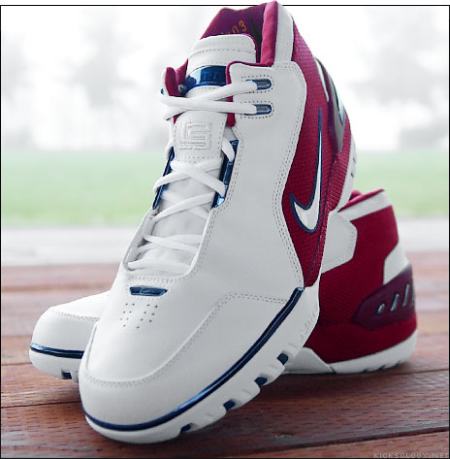 |
|---|
| Figure 6. Here’s one last look at the Nike Air Zoom Generation. If you look closely at the tongue you can see a series of dimples marking its surface. The dimples are the result of a repeating pattern of circles cut out of the thin layer of padding encased within the Zoom Generation’s bootie. It’s those dimples that make this a Sphere inner bootie – a first for Nike (see the full review for more on the Sphere inner bootie). Note also the very low-key LJ23 logo embroidered onto the tongue. All of the LeBron specific signifiers incorporated into the Air Zoom Generation are surprisingly subtle. |
These elements working together; the artful design of the outsole, the multi-purpose carbon fiber spring plate, and the beefy heel bumper, are what allowed me to play in the Air Zoom Generation without any concern directed towards my ankles. I’d go as far as to say that the shoe could have been a low-cut and I still would have felt the same. Now, no shoe can absolutely prevent an ankle injury (as LeBron learned when he landed awkwardly on another player’s foot in Utah last week), but the Air Zoom Generation does a better job than most.
Conclusion
Alright then, to sum up, the Nike Air Zoom Generation is a solid shoe for all-around players at any position. Allowing a bit too much front-to-back movement within the shoe and with an overly flat footbed, the Generation is not perfect. But it has a lot to offer in the areas of impact protection, cushioning feel, stability, and, most especially, comfort. Another plus is that its genuine, full-grain leather/textile upper should hold up very well over time – this even though the Generation is one of the lightest legitimate all-around/all-position shoes on the market today. No, it doesn’t mark a major advance in the design of athletic footwear, but the Air Zoom Generation does bring together a handful of truly useful technologies and, if you look at the complete package (Sphere inner bootie, carbon fiber spring plate, Zoom Air at the forefoot, standard Air-Sole unit at the heel), the shoe offers quite a bit of performance and content for its price. I wouldn’t characterize it as a value buy, but neither would I characterize it as an extravagance. The one group to whom I would strongly recommend the shoe are those who like the feel of Zoom Air at the forefoot, but want something a little more substantial at the heel. If that’s you, the Air Zoom Generation will almost certainly make you feel the part of the king.
by Professor K.
NikeLeBron.net Breakdown
| Comfort & Fit: |
         
|
9 |
|---|---|---|
| Cushioning: |
         
|
7 |
| Traction: |
         
|
9 |
| Stability: |
         
|
8 |
| Ankle support: |
         
|
7.5 |
| Weight: |
         
|
9.5 |
| Durability: |
         
|
8 |
| Ventilation: |
         
|
9 |
| Overall: |
         
|
8 |
Other Reviews


